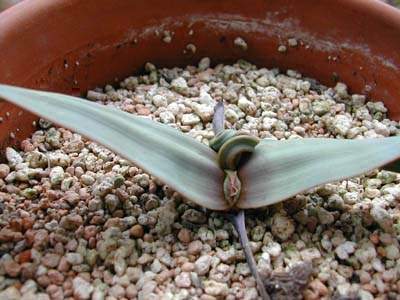CURIOSITIES FROM MY COLLECTION
Chris Hynes
Gymnocalycium mesopotamicum "Spiral Bound"
A visit to a large nursery always provides an opportunity to search through rows of plants looking for the ones that are different.
It was during a visit to Southfield nursery in Lincolnshire that I spotted a real gem of a plant. Hiding among about fifty pots of Gymnocalycium mesopotamicum Kiesling was one with astonishing flower structure. Instead of having flat petals rising from the centre of the flower and then curving downwards each petal did a ninety degree twist mid way along the length and then the curve towards the end of the petal, instead of going down went sideways. The entire flower was reminiscent of a propeller as it spiralled around (Photo 1, 2). Now it is always possible this was one abnormal or damaged flower and the rest will be ok, certainly the buds looked normal, but even so it was in my hand ready for purchase very quickly. Scanning the other flowers in the seed lot (it was from P124 seed) all flowers looked to be normal. G. mesopotamicum is a fairly recent discovery (1980) from Argentina, but in truth apart from that it seems to be a nice but fairly non-descript Gymno (despite the fact that John Pilbeam describes it as "an individual, striking new species"). Interestingly in some descriptions the flowers are reported to be white tinged pink while other descriptions say pure white.
As time progressed the next buds appeared and as they opened each one had the same spiralling effect, this has continued through several flushes of a few flowers per flush.
Some offsets have been detached and these will be grown on to ensure that they too have the same spiral flowers. A later visit to the nursery has shown no others that have this property – the plant is truly a special clone and has been given the name "Spiral Bound". So far no seed has been set – this is my only plant of this species so that is not surprising, an attempt to induce self pollination using pollen from Mammillaria has so far failed.
Gymnos with odd characters are not too unusual, I have a G. baldianum with wrinkled skin, and a couple of plants with no organised growing points as well as others with short/long spines etc. but this plant is 'pretty' and with its repeat flowering is going to be a worth addition to any collection.
A cristate Welwitschia mirabilis
Succulent plant growers often grow species that are xerophytic rather than succulent. These include many of the bromeliads as well as some of the gems of the plant kingdom such as Welwitschia mirabilis Hooker.
 |
| Photo 4. |
This plant grows in the Namib desert and consists of a caudex that produces only two strap like leaves that grow continuously and wear away at the ends. This is a CAM plant that has a long tap-root, but at the same time depends on the frequent fog to provide moisture. Cones are produced from the caudex, the plant is dioecious so male cones are produced on separate plants from female cones.
Seeds are large and winged but suffer in the wild (and in cultivation!) from fungus problems. They produce a long tap-root that if broken or damaged will kill the plant. At about 6 months old the tap-root branches and then it becomes more resistant to minor damage. This means that raising the plants is a problem and people often resort to raising one seed in a clay drainpipe. In practice I have found that transplanting early with great care solves the problem and after that transplanting is much easier.
The plant is not really a true succulent and should not be allowed to fully dry out, especially as a small plant. The two seed leaves soon wither as they are replaced by the two true leaves and despite the growth being quite slow it is steady.
I managed to get seed from South Africa and from 100 seeds germinated about 40, and raised to six months old about twenty five. I have kept a dozen of these and the rest have found homes elsewhere. Some I keep on the windowsill and some in the greenhouses. Those on the windowsill grow more slowly (but are more secure in the winter). All are kept reasonably watered, I use a very free draining, mineral compost so they need frequent watering.
At the centre of each small plant are two raised conical structures that form the caudex. In one particular case a plant had one 'normal' conical structure, while the other was more of a linear structure. Over time this has slowly developed into a zig-zagging ribbon, and it has become obvious that this is a cristate structure. This surprised me because only half of the central caudex has become cristate – but it continues to grow and the leaves seem to be growing normally (Photo 3-5).
It will be interesting to watch what happens to this plant over the next few years. I have not heard of a cristate Welwitschia but then I have seen very few other than those I have raised so it is hard to know how rare this one is.





